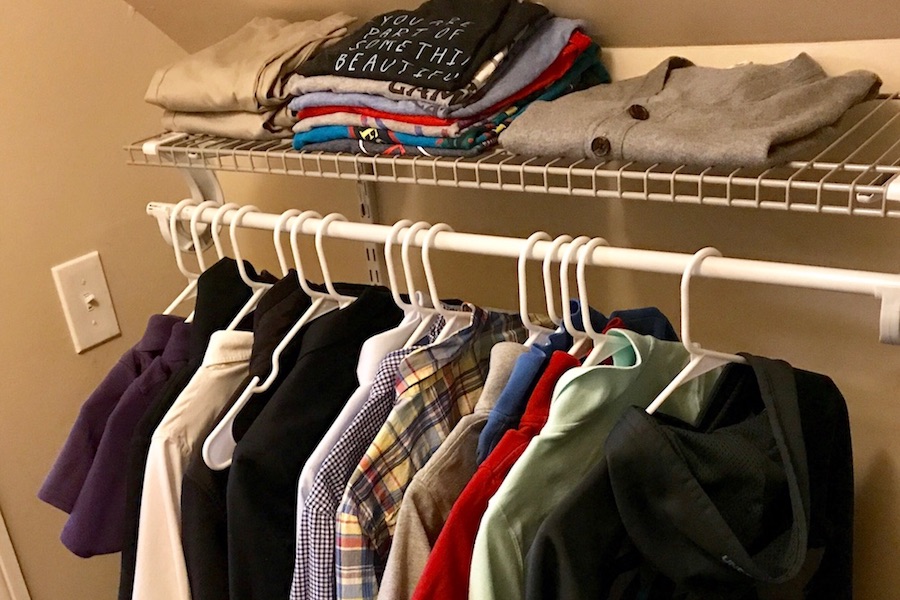I am happy to admit it: Marie Kondo is my guru. I love the concepts of capsule wardrobes, minimalist decor and paring down the clutter in my life overall. There is very little in my home that stresses me out more than piles of stuff — which is why I have done my best to completely avoid my kids’ closets for ages now.
But with school starting, I knew it was time to get in there and assess the situation.
You guys, it was bad.
My 7 year old still had size 3T shirts he wouldn’t give up, and my daughter had been hoarding approximately 1,723 t-shirts.
It was time for a purge.
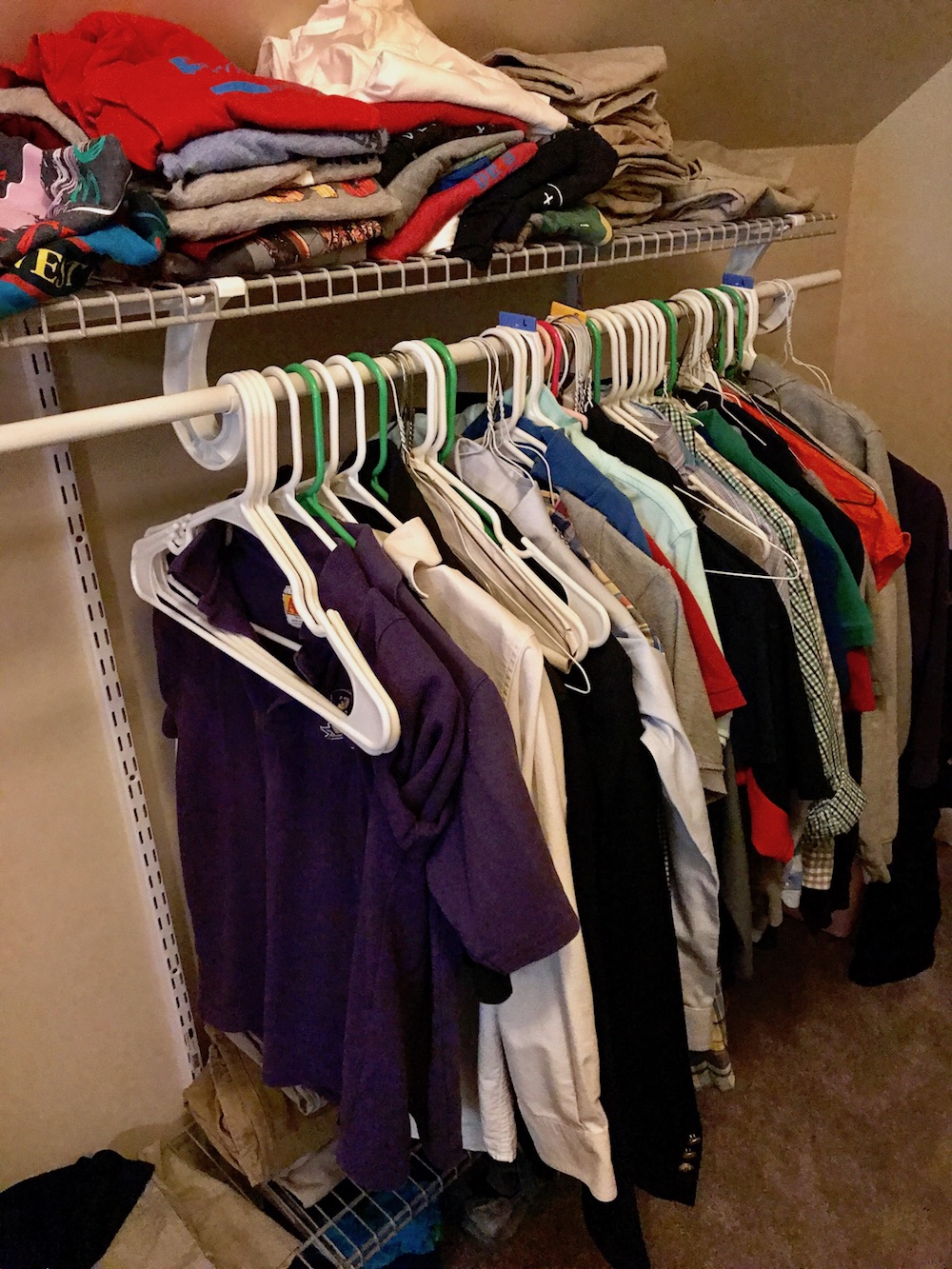
Before. It was worse than the photo looks, really.
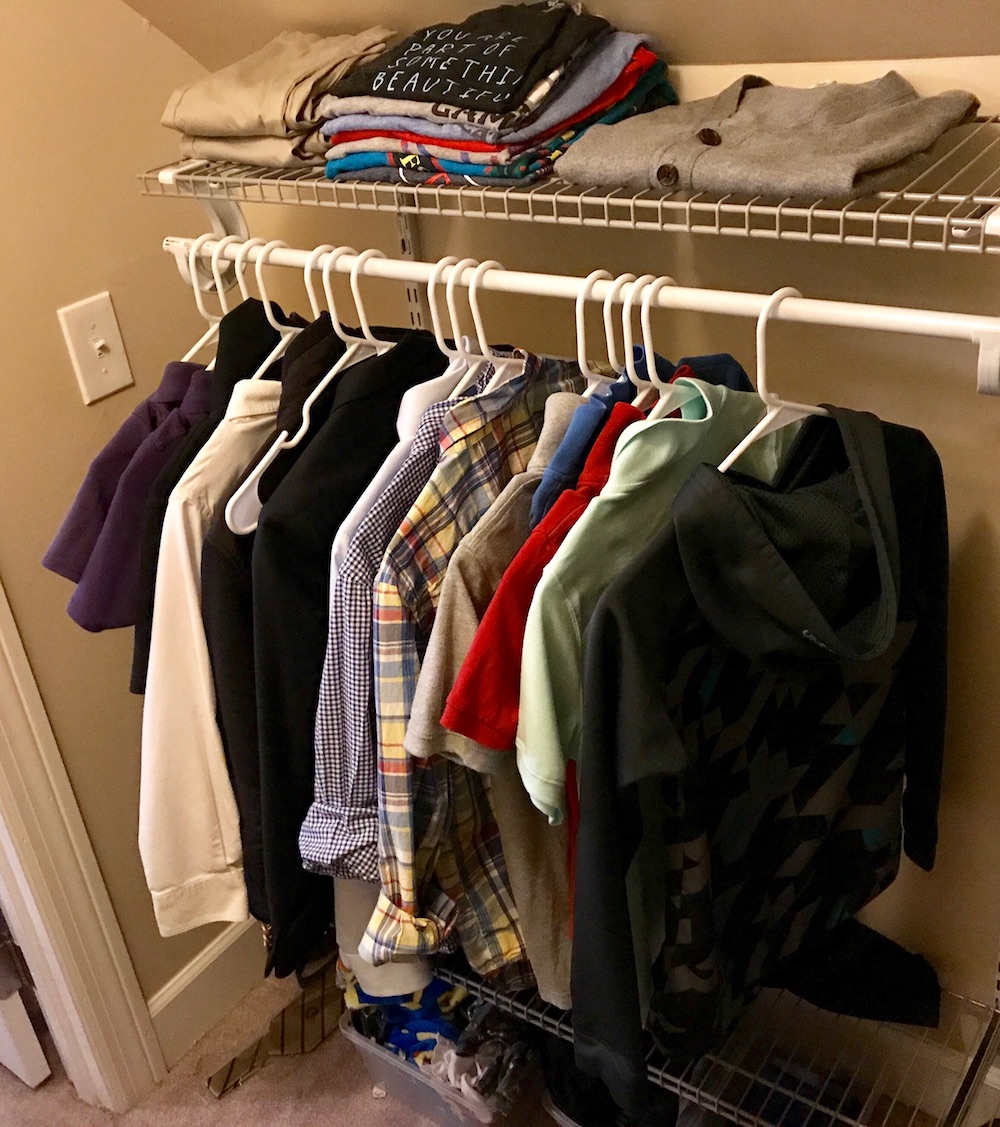
After. Bliss!
Related: One quick laundry tip that will save you loads (ha!) of time
So, I seriously streamlined what we kept in their closets and created a series of capsule wardrobes…for kids.
It’s not instant nirvana (there’s still laundry to do, and more than I’d like at that), but it’s a whole lot better than what we had going on in there. Here’s what you can do if you’re thinking of doing the same, and how it might work for you.
Step 1: Do the laundry first
There’s no point in purging if you’ve still got a big pile of laundry out there, which will bring tons more clothes right back into the closets. So don’t forget to get everything clean and in one place before you start.
Step 2: Send the kids away. For now.
I know, I know…we’re supposed to be training our kids to be independent and do things on their own. But you know your kids best, and if yours are like mine, they’re going to tell you that every one of those 1200+ t-shirts are “special.”
I’ve found it’s better to get started on purging without them around, send them to the playroom to watch a movie, then bringing them back later when I need them.
But if you have kids who really enjoy purging and organizing and donating, and you really think they’ll be helpful, then put them to work!
Step 3: Get rid of anything that doesn’t fit
To pare down your kids’ wardrobes, the best first place to start is simply determining what fits and what doesn’t.
So go full Marie Kondo and dump everything they own on the floor. Take a couple of trash bags and recycling bags with you into the closet and pump up your favorite Pandora station. Then start going through the pile, item by item and label by label.
If that size 4T shirt is too small and still in good condition, put it in a donate bag. If it’s in bad condition, recycle it.
Please keep in mind that if you don’t want those dirty, outgrown shoes or that ripped pair of underwear, no one else does. Don’t send it to a charity or resell store and force them to throw it out for you; their resources are probably already taxed.
Related: Free labor! A helpful guide to chores for kids by age
Step 4: Make piles by clothing item
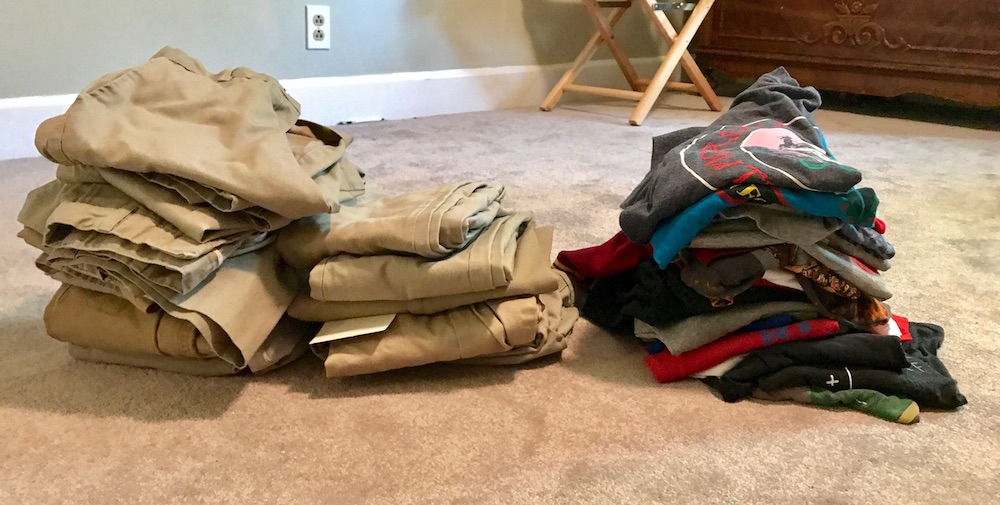
Organize the clothes that still fit by type: One pile of shorts, one pile of jeans, one pile of school uniform skirts, one pile of dresses, and so on.
This is so helpful because it helps you really see how many of each item you actually have; it’s way easier to toss an iffy pair of jeans when you know there are five others that are in better condition.
And really, seeing a pile of 8 pairs of jeans made it abundantly clear to me that my son didn’t need that many. So don’t skip this step. You need the visual.
Tip: No child needs 37 t-shirts. Even if they are all his favorite. (How do t-shirts accumulate so quickly anyway? Geez.)
Another Tip: This could be a great time to go ahead and toss anything you hate. Just putting that out there.
Step 5: Take a break.
You’re allowed a break between steps 4 and 6. Take a shower. Read the next chapter in your book. Grab a latte. Paint your toes. Write a letter to a long lost friend. Check your Instagram. Do some yoga. Watch the latest Game of Thrones episode you missed because your kid wouldn’t go to bed on time and you were too exhausted to watch it after they finally fell asleep.
When you’re mentally prepared for step 6, only then should you bring the kids back. Preferably one at a time.
Step 6: Talk through each pile with your child
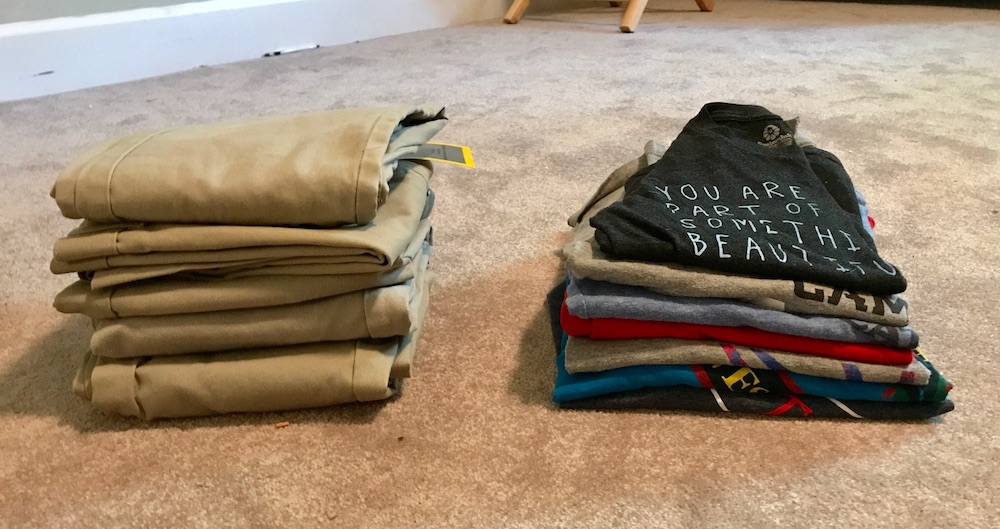
Get a number in your head of how many articles of each type of clothing your child needs. Then employ your kids so it becomes their choice what to get down to that number.
I decided to create a capsule wardrobe for my kids based on how often I wanted to do laundry, which is once a week. Also, my kids wear school uniforms so that limits the number of other items they need for school days.
So your numbers may look different than mine, but here are the numbers I was aiming for:
- School uniforms: 5 sets
- Jeans: 2
- Dressy pants: 2-3
- Dress shirts: 3
- Nice shorts: 2-3
- Play shorts: 5
- T-shirts: 7 (gulp, I know)
- Dresses: 3-4
- PJs: 5
- Jackets/sweaters: 3 (though keep in mind I’m in a warm southern climate)
From here, kids free to keep whatever items were their favorites — provided they ended up with the number I specified. It’s also helpful for them to consider whether a “favorite” is some neon green sparkly crazy sweater that goes with literally nothing else they own.
(When they have a limited number of items, they want to make sure they actually get to wear them, you know?)
Of course, paring down to these numbers meant that we also ended up donating some clothes we actually liked. This was hardest for my daughter, who really loves her clothes. Using Marie Kondo’s advice to keep only the items that “spark joy” really helped; this way, she realized it was possible to have a closet full of only clothes she truly loves.
And — spoiler alert — she hasn’t missed anything she tossed, now that they’re gone. Plus donating clothes in very good condition to a worthy charity or selling them through a resale service feels terrific.
Bonus: It gave my kids permission to toss items they were only keeping because their Granny or Aunt So-and-So gave it to them. I think that was actually cathartic for them.
Related: A cool way to get a toddler’s closet organized. For free.
Step 7: Don’t include sports stuff in your capsule wardrobe
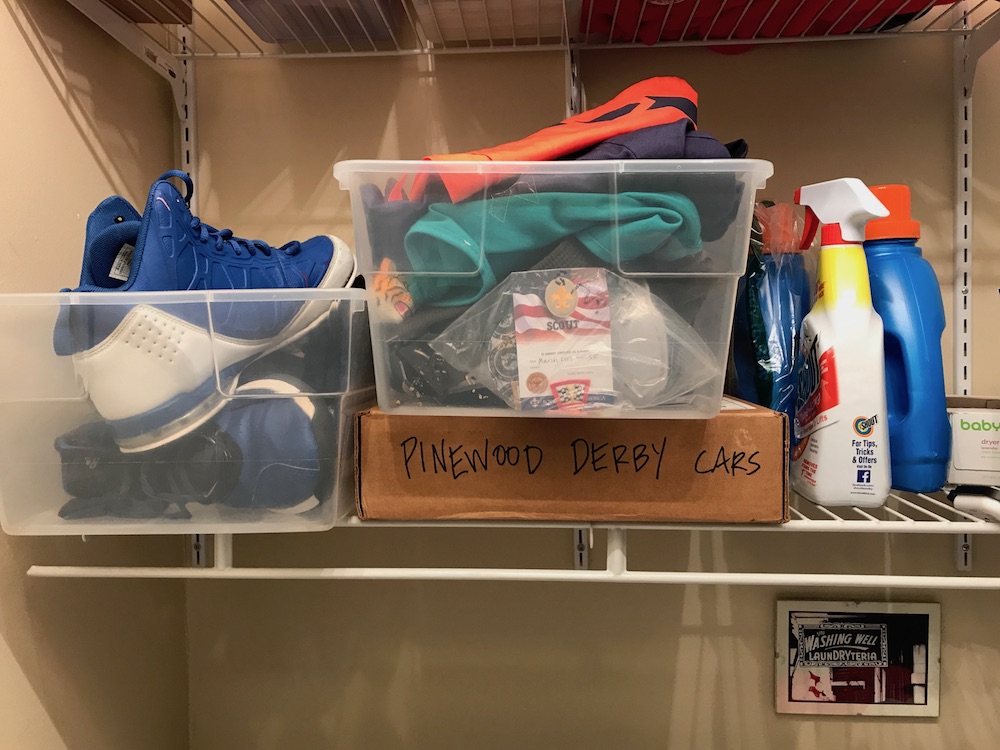
It’s been helpful for our family to have sports uniforms and shoes, dance costumes, and scouting uniforms easily accessible elsewhere, instead of buried deep in the kids’ closets. It makes those things easier to find when we need them — and makes it easier to see their regular clothing without all the extra clutter.
We now have buckets for each sport stacked in the laundry room (which is near our front door) with everything the kid needs for that activity in one place.
Another method is to use old backpacks or cinch bags to stow each set of items, so you can just grab them and go. But whatever works for you, depending on the activity is fine — clearly, hockey sticks are not going to fit in the same place that ballet shoes will.
Step 8: Let your kids see where their clothes end up.
In my sons’ closet alone, we ended up with four bags of clothes to donate. Wow.
In the past, I’ve taken things to local consignment shops and been surprised by how much money I’ve gotten for it all. And there’s nothing wrong with that — show them the receipts and they’ll understand the impact of their actions.
This time however, I donated our uniforms to a family at school who could use them, and they helped pass the rest of our items to a refugee family they work with.
For those kids, it was the difference between having a winter coat and not having one this year.
When my kids saw that, it finally clicked for them, and they realized just exactly why they didn’t need four different winter coats in their closets. And that alone made all this work creating capsule wardrobes for my kids worth it.
